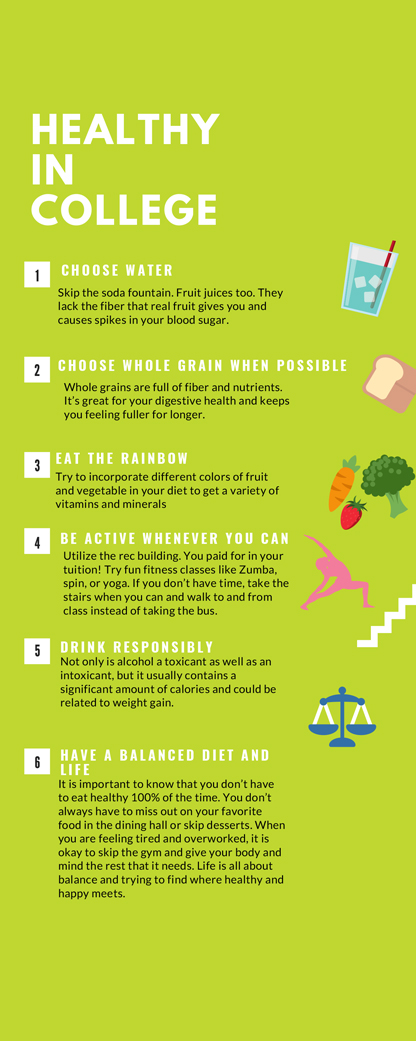Don’t Fixate on Fifteen: Healthy Lifestyle Choices for College Freshmen

Ngan Nguyen
Bachelor’s Student in Public Health
[Student Org Pursuit Takeover]
Students Creating the Conversation
Check out other articles by student org leaders on The Pursuit.
The truth about the “Freshman 15” is that there is no truth behind it, at least not behind the number 15.
If you’re not familiar with the term, “Freshman 15” refers to the idea that first-year college and university students gain roughly 15 pounds during that first year of the higher-education experience due to reduced exercise and increased caloric intake.
Looking at a total of 30 studies, the average weight gain for all first-year college and university students combined—that is, including those who lost weight—was 3.3 lbs. If you look only at those who gained weight that first year, the average weight gain of that population was 7.5 lbs.1
So where did the number 15 come from?
The myth has bounced around since its murky early days and seems to have found a staying place among first-year students.
It appears the first documented reference of this phenomenon was in Seventeen magazine’s August 1989 issue,2 including a reference on the cover to “fighting the freshman 15.” Prior to that, we see references to the “freshman 10,” including a reference to actor Jodi Foster’s experience as an undergraduate student at Yale University in a 1981 New York Times article. The myth has bounced around since its murky early days and seems to have found a staying place among first-year students.3
While not statistically accurate, college-student eating, drinking, and physical activity habits are a major concern to students, parents, and health professionals. The transition to college is marked by drastic changes in both dietary preferences and physical activity. In a study examining the health behaviors of college students, scientists found that most college students do not exercise or eat healthily.4
- 84% do not eat fruits on a daily basis
- 83% do not eat vegetables on a daily basis
- A majority of the students did not meet recommended physical activity guidelines of 30 minutes ≥ 5 days per week
As a college student, I do not find these data surprising. Many barriers to healthy eating, drinking, and physical activity present themselves to college students, especially in the first year of higher education.
It is difficult to maintain a healthy lifestyle in college when alternatives are so much easier.
Between classes, studying, interacting with peers, engaging in various student organizations, sleeping, and so on, I find it extremely difficult to find time to exercise regularly. Most of my college eating habits have been formed around the food served in the dining hall, where I often find myself choosing what tastes better over what is healthier.
It is difficult to maintain a healthy lifestyle in college when alternatives are so much easier. To help out those of you reading this who are college students, I have compiled this list of ways we can think about maintaining better eating and exercising habits through simple, small changes in behavior.

Whether the number is 3.3 or 15, the important thing is that college students make healthy choices that support their academic, professional, and personal goals and not fixate on a single data point like weight.
References
- Vadeboncoeur, Townsend, and Foster, “A Meta-Analysis of Weight Gain in First Year University Students: Is Freshman 15 a Myth?” BMC Obesity 2 (May 2015): 22.
- Anderson, Sarah, “The 'Freshman 15' Was Invented to Sell Magazines,” Thrillist (Sept 2016).
- Khazan, Olga. “The Origin of the ‘Freshman 15’ Myth,” The Atlantic (Sept 2014).
- Downes, Loureen, “Physical Activity and Dietary Habits of College Students,” Journal for Nurse Practitioners 11/2 (February 2015): 192-98.
- Read more articles by Michigan Public Health students.
- Learn more about student advocacy work at Michigan Public Health.
- Support research at Michigan Public Health.
ABOUT THE AUTHOR
 Ngan Nguyen is a bachelor's student at the University of Michigan School of Public
Health. She hopes to find a career in public health that will allow her to support
individuals in our communities by connecting locally and personally with people and
helping them lead happy, healthy lives. She is involved with Pencils of Promise Michigan,
a University of Michigan student organization founded by her sister.
Ngan Nguyen is a bachelor's student at the University of Michigan School of Public
Health. She hopes to find a career in public health that will allow her to support
individuals in our communities by connecting locally and personally with people and
helping them lead happy, healthy lives. She is involved with Pencils of Promise Michigan,
a University of Michigan student organization founded by her sister.
